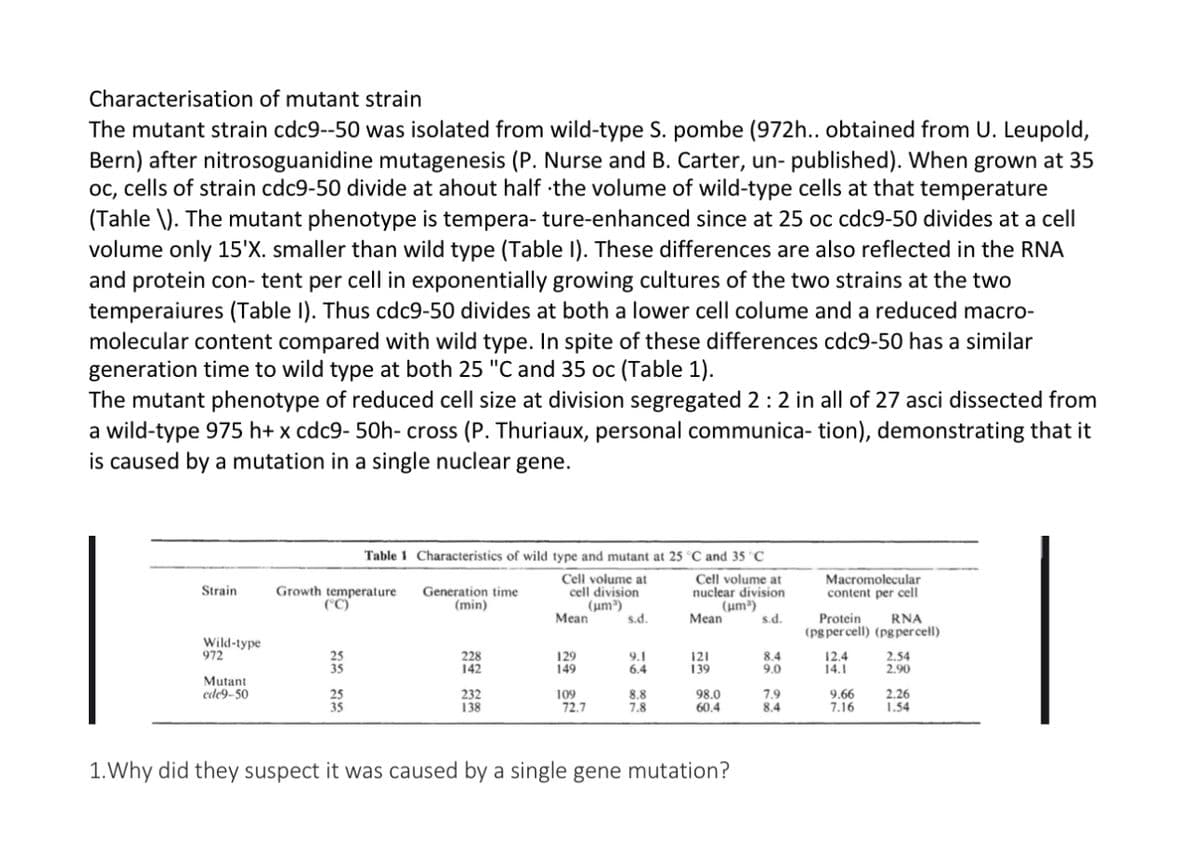Strain Wild-type 972 Mutant ede9-50 Growth temperature (°C) 25 35 Table 1 Characteristics of wild type and mutant at 25 C and 35 °C Cell volume at cell division Cell volume at nuclear division (μm³) (μm³) Mean Mean s.d. 25 35 Generation time (min) 228 142 232 138 129 149 109 72.7 s.d. 9.1 6.4 8.8 7.8 121 139 98.0 60.4 1. Why did they suspect it was caused by a single gene mutation? 8.4 9.0 7.9 8.4 Macromolecular content per cell Protein RNA (pg percell) (pg percell) 12.4 14.1 9.66 7.16 2.54 2.90 2.26 1.54
Strain Wild-type 972 Mutant ede9-50 Growth temperature (°C) 25 35 Table 1 Characteristics of wild type and mutant at 25 C and 35 °C Cell volume at cell division Cell volume at nuclear division (μm³) (μm³) Mean Mean s.d. 25 35 Generation time (min) 228 142 232 138 129 149 109 72.7 s.d. 9.1 6.4 8.8 7.8 121 139 98.0 60.4 1. Why did they suspect it was caused by a single gene mutation? 8.4 9.0 7.9 8.4 Macromolecular content per cell Protein RNA (pg percell) (pg percell) 12.4 14.1 9.66 7.16 2.54 2.90 2.26 1.54
Biochemistry
6th Edition
ISBN:9781305577206
Author:Reginald H. Garrett, Charles M. Grisham
Publisher:Reginald H. Garrett, Charles M. Grisham
Chapter28: Dna Metabolism: Replication, Recombination, And Repair
Section: Chapter Questions
Problem 16P: Helicase Unwinding of the E. coli Chromosome Hexameric helicases, such as DnaB, the MCM proteins,...
Related questions
Topic Video
Question

Transcribed Image Text:Characterisation of mutant strain
The mutant strain cdc9--50 was isolated from wild-type S. pombe (972h.. obtained from U. Leupold,
Bern) after nitrosoguanidine mutagenesis (P. Nurse and B. Carter, un- published). When grown at 35
oc, cells of strain cdc9-50 divide at ahout half the volume of wild-type cells at that temperature
(Tahle \). The mutant phenotype is tempera- ture-enhanced since at 25 oc cdc9-50 divides at a cell
volume only 15'X. smaller than wild type (Table I). These differences are also reflected in the RNA
and protein con- tent per cell in exponentially growing cultures of the two strains at the two
temperaiures (Table I). Thus cdc9-50 divides at both a lower cell colume and a reduced macro-
molecular content compared with wild type. In spite of these differences cdc9-50 has a similar
generation time to wild type at both 25 "C and 35 oc (Table 1).
The mutant phenotype of reduced cell size at division segregated 2:2 in all of 27 asci dissected from
a wild-type 975 h+ x cdc9- 50h- cross (P. Thuriaux, personal communica- tion), demonstrating that it
is caused by a mutation in a single nuclear gene.
Table 1 Characteristics of wild type and mutant at 25 C and 35 C
Cell volume at
cell division
(µm³)
Mean
Cell volume at
nuclear division
(um³)
Mean
Growth temperature
(°C)
Macromolecular
content per cell
Strain
Generation time
(min)
s.d.
s.d.
Protein
RNA
(pg per cell) (pgper cell)
Wild-type
972
228
142
129
149
9.1
6.4
121
139
8.4
9.0
12.4
14.1
2.54
2.90
35
Mutant
cde9-50
232
138
109
72.7
8.8
7.8
98.0
60.4
7.9
8.4
9.66
1.16
2.26
1.54
1.Why did they suspect it was caused by a single gene mutation?
Expert Solution
This question has been solved!
Explore an expertly crafted, step-by-step solution for a thorough understanding of key concepts.
Step by step
Solved in 2 steps

Knowledge Booster
Learn more about
Need a deep-dive on the concept behind this application? Look no further. Learn more about this topic, biology and related others by exploring similar questions and additional content below.Recommended textbooks for you

Biochemistry
Biochemistry
ISBN:
9781305577206
Author:
Reginald H. Garrett, Charles M. Grisham
Publisher:
Cengage Learning

Biochemistry
Biochemistry
ISBN:
9781305577206
Author:
Reginald H. Garrett, Charles M. Grisham
Publisher:
Cengage Learning